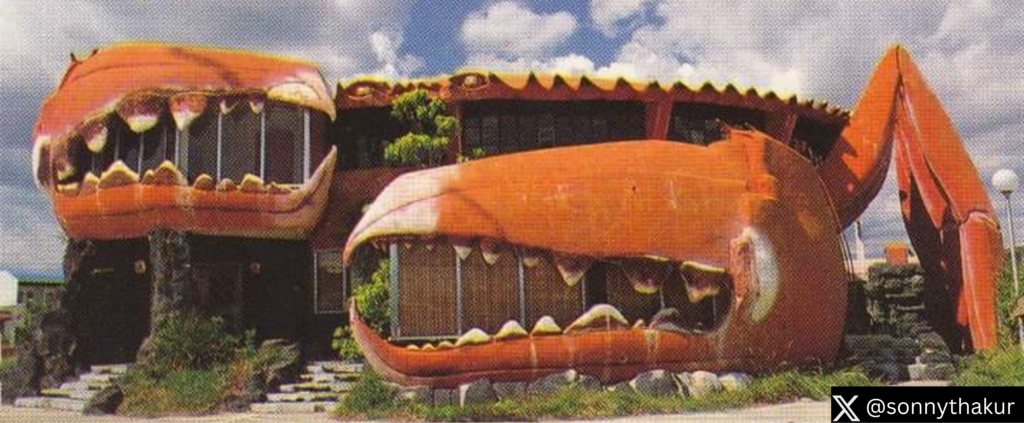The ALIMANGO architectural design in Arellano Street, Dagupan City. It is a notable landmark that holds a special place in the region’s cultural and historical landscape. Constructed in the 1970s, this building originally functioned as a restaurant and disco bar, known as the ALIMANGO, which means “crab” in Filipino. The structure is renowned for its unique design, which emulates the form of a giant crab, making it an eye-catching and memorable sight.
Architectural Design and Purpose
The architectural concept behind the ALIMANGO was both innovative and symbolic. Designed to resemble a crab, the building reflects the local significance of seafood, particularly crabs, in Dagupan’s culinary traditions. This thematic design was intended to attract both locals and tourists, providing a distinctive dining experience that was deeply rooted in the local culture. The restaurant offered a menu that likely featured various seafood dishes, aligning with its crab-themed exterior, while the disco bar provided entertainment, making it a popular nightlife destination during its operational years.
Historical Context
In the 1970s, the ALIMANGO restaurant and disco bar emerged as a social hub in Dagupan City. Its unique architectural design made it a tourist attraction, with many visitors ensuring they captured photographs with the iconic structure. The building not only served as a dining and entertainment venue but also contributed to the city’s identity, celebrating its maritime heritage and the centrality of seafood in local cuisine
The Alimango Restaurant in Dagupan City, once a popular and expensive seafood establishment, has long been the subject of rumors and speculation since its sudden closure after just a year of operation. The restaurant, which also housed a disco on its second floor, was known for its high prices, attracting only the wealthy. However, its abrupt shutdown led to various rumors, including tales of the owner being murdered and the establishment being a front for a drug den.
Decline and Abandonment
Despite its early popularity, the ALIMANGO ceased operations over 30 years ago. The reasons for its closure are not well-documented, but like many businesses, it likely faced economic and operational challenges that led to its eventual abandonment. The restaurant closure may due to financial mismanagement and the inability to pay its employees. The business, funded primarily by investors, struggled to cover wages, leading to employee dissatisfaction and eventually a lawsuit against the management. This case, however, appears to have been forgotten, as the Department of Labor and Employment has no records of it, and no follow-up was made.
The property, now owned by a Chinese businessman named Enoch Tan, remains abandoned and has become a landmark in Dagupan City. Despite public interest in reopening or repurposing the building, such as turning it into a tourist spot or gallery, the current owners have no immediate plans for redevelopment, though they have considered it for the future. The building’s past, including the unresolved grievances of its former employees, continues to linger, with no resolution in sight.
Today, the building stands vacant, a relic of its former glory, yet it continues to draw interest due to its distinctive design and historical significance. The structure has also faced issues related to vandalism and neglect, with efforts made by tenants and local authorities to protect it from further damage
Cultural and Historical Legacy
The ALIMANGO building remains an enduring symbol of Dagupan’s rich cultural heritage. It represents a period when innovative architectural designs were employed to celebrate and promote local culture and cuisine. The building’s crab-like design is a testament to the creativity and cultural pride of its creators, offering a tangible link to the past for current and future generations.
The architectural design of the ALIMANGO has also sparked discussions about heritage preservation and the potential for repurposing abandoned historical buildings. There are various viewpoints on how to best utilize such structures, ranging from restoration projects that preserve their original purpose to adaptive reuse that transforms them into new functional spaces while retaining their historical significance.
The ALIMANGO architectural design in Dagupan City is more than just an abandoned building; it is a cultural icon that reflects the region’s historical and culinary heritage. Its unique crab-like design continues to capture the imagination and interest of those who visit or remember its vibrant past. As Dagupan City evolves, the legacy of the ALIMANGO serves as a reminder of the importance of preserving and celebrating local cultural landmarks.

